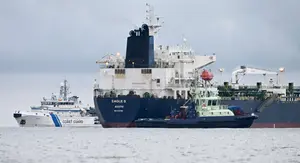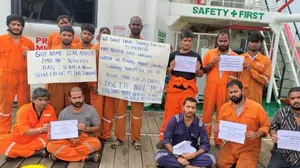European leaders, concerned about U.S. President Donald Trump’s potential quick ceasefire push in Ukraine, have begun threatening severe actions against Russia regarding its “shadow fleet.” This fleet consists of tankers disguised under different flags to evade the G7 price cap on Russian oil exports. Notably, Russia has recently carried out military actions to protect these vessels, escalating tensions in the Baltic Sea.
In May 2025, a series of incidents underscored Russia’s response to growing European scrutiny. A Russian fighter jet circled a shadow fleet oil tanker, the Jaguar, which was under Estonian escort, violating NATO airspace. Shortly after, Russian authorities detained a Greek-owned oil tanker, the Green Admire, and Polish forces patrolled to deter another suspicious vessel. These actions not only highlight Russia’s military engagement on behalf of its shadow fleet but also suggest a broader strategy that may involve sabotaging critical undersea infrastructure in the Baltic Sea.
Concerns have arisen regarding the safety of vital subsea networks, with Estonian officials, led by Defense Minister Hanno Pevkur, fearing threats to undersea infrastructure like data cables and power connections. Past incidents have confirmed this anxiety, as shadow fleet vessels have been implicated in damaging such critical infrastructure. The risk extends beyond mere security threats to environmental hazards, as many of these vessels are aging and prone to spills.
There is an increasing demand for coordinated efforts among European nations to address these challenges. Prior responses to sabotage had been largely reactive, but recent events illustrate a shift towards a more proactive stance. Following earlier incidents, NATO and European allies have initiated closer surveillance and naval patrols in the region to ensure the protection of underwater structures. Agreements have emerged, such as a memorandum signed in January 2025, focusing on collaboration to protect critical infrastructure.
In navigating these challenges, legal considerations are paramount. The Jaguar incident exemplifies how Estonia utilized international law to justify its actions against unregistered vessels. However, future responses may be complicated by properly flagged ships, creating potential limitations under the United Nations Convention on the Law of the Sea (UNCLOS). Europe therefore needs to explore new interpretations of international law that could grant broader authority to apprehend vessels suspected of sabotage.
The emerging confrontations present critical concerns regarding military engagement. The presence of Russian military escorts accompanying shadow fleet vessels raises the stakes for European authorities. This situation engenders fears of direct clashes between NATO forces and Russian military, heightening geopolitical tensions. In light of a newly declared maritime exclusion zone by Russia, European states face significant risks in pursuing suspicious vessels.
As the situation evolves, European nations must not only act with legal justification but also build their capabilities to respond to threats effectively. Past incidents indicate that Western sanctions are impacting Russia, yet the risk of miscalculation remains considerable. The Baltic Sea has far-reaching implications for global security, and actions taken by European states in this area could influence international responses to maritime threats elsewhere. By seizing the opportunity to establish robust frameworks for addressing hybrid threats, Europe can shape future maritime security dynamics and enhance its resilience against these challenges.
Source link



